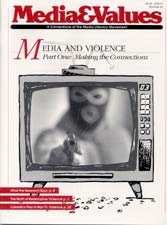Measuring 'Jolts Per Minute'
|
This article originally appeared in Issue# 62
|
"Jolts per minute" programming is often cited as a principle — almost a first law — of commercial television. "Jolt" refers to the moment of excitement generated by a laugh, a violent act, a car chase, a quick film cut — any fast-paced episode that lures the viewer into the program. Television and screen writers often inject a jolt into their scripts to liven up the action or pick up the pace of a story.
Measuring the jolts per minute is a good way to discover how violence is used to keep the viewer's interest. When we consider the sheer number of violent acts we're exposed to for the sake of maintaining our attention, we can begin to understand how we're "jolted" into believing that the only thing that can keep our interest IS violencve. Here are some thigs you can do to keep from getting over-jolted:
- Explore what is meant by "jolts" in media messages. Come up with a list of the many different construction elements that could be considered "jolts"? Does a "jolt" have to be violent? Don't forget color, sound, music. Can a printed message contain a "jolt?"
- What type of jolts of violence are most common in your viewing? Consider alternatives to using violence as a jolt. Would a joke work in place of a fist fight? How would this affect the story?
- Observe promos for upcoming television shows or feature films. Are the clips mostly scenes of violence? What about promos for the late night news? How do news promos differ from promos for entertainment?
- MTV has gained a reputation for quick edits and splashy graphics. Are the quick cuts themselves acts of violence to our senses? What types of videos use more jolts of violence than others?
Based on media awareness activities in Media Literacy Resource Guide published by the Ministry of Education, Ontario, Canada.



